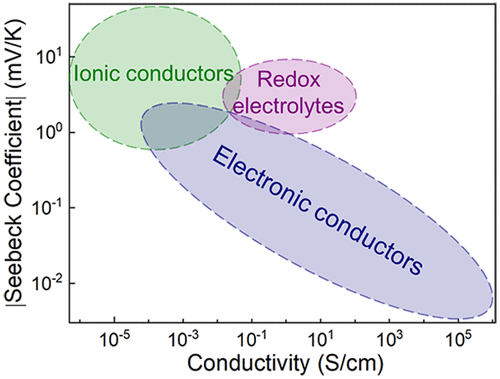当前位置:
X-MOL 学术
›
Chem. Rev.
›
论文详情
Our official English website, www.x-mol.net, welcomes your feedback! (Note: you will need to create a separate account there.)
Unconventional Thermoelectric Materials for Energy Harvesting and Sensing Applications
Chemical Reviews ( IF 62.1 ) Pub Date : 2021-08-16 , DOI: 10.1021/acs.chemrev.1c00218 Matteo Massetti 1 , Fei Jiao 1, 2 , Andrew J Ferguson 3 , Dan Zhao 1 , Kosala Wijeratne 1 , Alois Würger 4 , Jeffrey L Blackburn 3 , Xavier Crispin 1 , Simone Fabiano 1
Chemical Reviews ( IF 62.1 ) Pub Date : 2021-08-16 , DOI: 10.1021/acs.chemrev.1c00218 Matteo Massetti 1 , Fei Jiao 1, 2 , Andrew J Ferguson 3 , Dan Zhao 1 , Kosala Wijeratne 1 , Alois Würger 4 , Jeffrey L Blackburn 3 , Xavier Crispin 1 , Simone Fabiano 1
Affiliation

|
Heat is an abundant but often wasted source of energy. Thus, harvesting just a portion of this tremendous amount of energy holds significant promise for a more sustainable society. While traditional solid-state inorganic semiconductors have dominated the research stage on thermal-to-electrical energy conversion, carbon-based semiconductors have recently attracted a great deal of attention as potential thermoelectric materials for low-temperature energy harvesting, primarily driven by the high abundance of their atomic elements, ease of processing/manufacturing, and intrinsically low thermal conductivity. This quest for new materials has resulted in the discovery of several new kinds of thermoelectric materials and concepts capable of converting a heat flux into an electrical current by means of various types of particles transporting the electric charge: (i) electrons, (ii) ions, and (iii) redox molecules. This has contributed to expanding the applications envisaged for thermoelectric materials far beyond simple conversion of heat into electricity. This is the motivation behind this review. This work is divided in three sections. In the first section, we present the basic principle of the thermoelectric effects when the particles transporting the electric charge are electrons, ions, and redox molecules and describe the conceptual differences between the three thermodiffusion phenomena. In the second section, we review the efforts made on developing devices exploiting these three effects and give a thorough understanding of what limits their performance. In the third section, we review the state-of-the-art thermoelectric materials investigated so far and provide a comprehensive understanding of what limits charge and energy transport in each of these classes of materials.
中文翻译:

用于能量收集和传感应用的非常规热电材料
热量是一种丰富但经常被浪费的能源。因此,仅收集这些巨大能量的一部分就为更可持续的社会带来了巨大的希望。虽然传统的固态无机半导体在热电能量转换的研究阶段占据主导地位,但碳基半导体最近作为用于低温能量收集的潜在热电材料引起了广泛关注,这主要是由高丰度驱动的。它们的原子元素,易于加工/制造,以及固有的低导热性。这种对新材料的探索导致发现了几种新的热电材料和概念,它们能够通过各种类型的粒子传输电荷将热通量转化为电流:(i)电子,(ii)离子, 和 (iii) 氧化还原分子。这有助于扩展为热电材料设想的应用,远远超出简单地将热转化为电能。这是本次审查背后的动机。这项工作分为三个部分。在第一节中,我们介绍了当粒子传输电荷时热电效应的基本原理 这有助于扩展为热电材料设想的应用,远远超出简单地将热转化为电能。这是本次审查背后的动机。这项工作分为三个部分。在第一节中,我们介绍了当粒子传输电荷时热电效应的基本原理 这有助于扩展为热电材料设想的应用,远远超出简单地将热转化为电能。这是本次审查背后的动机。这项工作分为三个部分。在第一节中,我们介绍了当粒子传输电荷时热电效应的基本原理电子、离子和氧化还原分子,并描述了三种热扩散现象之间的概念差异。在第二部分中,我们回顾了在开发利用这三种效应的设备方面所做的努力,并全面了解限制其性能的因素。在第三部分中,我们回顾了迄今为止研究的最先进的热电材料,并全面了解限制这些材料中电荷和能量传输的因素。
更新日期:2021-08-16
中文翻译:

用于能量收集和传感应用的非常规热电材料
热量是一种丰富但经常被浪费的能源。因此,仅收集这些巨大能量的一部分就为更可持续的社会带来了巨大的希望。虽然传统的固态无机半导体在热电能量转换的研究阶段占据主导地位,但碳基半导体最近作为用于低温能量收集的潜在热电材料引起了广泛关注,这主要是由高丰度驱动的。它们的原子元素,易于加工/制造,以及固有的低导热性。这种对新材料的探索导致发现了几种新的热电材料和概念,它们能够通过各种类型的粒子传输电荷将热通量转化为电流:(i)电子,(ii)离子, 和 (iii) 氧化还原分子。这有助于扩展为热电材料设想的应用,远远超出简单地将热转化为电能。这是本次审查背后的动机。这项工作分为三个部分。在第一节中,我们介绍了当粒子传输电荷时热电效应的基本原理 这有助于扩展为热电材料设想的应用,远远超出简单地将热转化为电能。这是本次审查背后的动机。这项工作分为三个部分。在第一节中,我们介绍了当粒子传输电荷时热电效应的基本原理 这有助于扩展为热电材料设想的应用,远远超出简单地将热转化为电能。这是本次审查背后的动机。这项工作分为三个部分。在第一节中,我们介绍了当粒子传输电荷时热电效应的基本原理电子、离子和氧化还原分子,并描述了三种热扩散现象之间的概念差异。在第二部分中,我们回顾了在开发利用这三种效应的设备方面所做的努力,并全面了解限制其性能的因素。在第三部分中,我们回顾了迄今为止研究的最先进的热电材料,并全面了解限制这些材料中电荷和能量传输的因素。



























 京公网安备 11010802027423号
京公网安备 11010802027423号